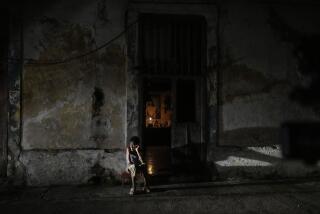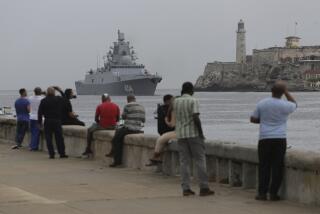Reporter’s Notebook : In Havana, a Soviet-Built Lada Is the Car to Drive
HAVANA — A few years ago, foreign visitors were often struck by the predominance of 1950s American cars on Havana streets. Some of the old cars are still running, but what is striking now is the number of new Ladas. The compact, boxy Lada, a Soviet-built Fiat, is everywhere.
The gray police cars are Ladas, as are the newest taxis. Middle-level bureaucrats drive the Lada, but officials at higher levels get a Volga, a bigger Soviet car.
For the highest officials, the car of choice is the West German Mercedes Benz.
“Fidel Castro,” a diplomat said, “always comes in a first-class Mercedes.”
A middle-level bureaucrat said privately that he would not want a Lada even if he could save the $6,000 it costs and get the government authorization required to buy one.
“It isn’t the price,” he said, “it’s what it costs to maintain a car.”
According to the bureaucrat, mechanics in government garages steal parts from cars being repaired, and free-lance mechanics charge a fortune for their work.
“You have to have two salaries, one for the family and one for the car,” the bureaucrat said. “I’d rather have a bicycle.”
But a common bicycle costs $350, and he thinks that is too much. His salary is $195 a month. So he walks, or takes a bus. The fare: 5 cents.
Diplomats in Havana have found that the way to get extra servants for a party is to offer U.S. dollars or other hard currency, known as papelito or “little paper,” in Cuban slang.
Waiters and cooks are immediately available for $16 or $17 a night in papelito , one diplomat said. He added:
“Without papelito you can’t get anything. They work only on a hard-currency basis.”
For Cubans it is illegal to possess Western currency but it is nonetheless in demand, mainly because of “diplomatic stores” that have been opened in tourist hotels and offer coveted designer clothes and electronic gear.
If a Cuban has the dollars to buy a pair of French jeans or a Japanese stereo, all he needs is a foreign friend to go to the hotel and make the purchase for him.
Black market dollars cost about four pesos each. At the official rate of exchange, the peso is worth 87 U.S. cents.
Cuba’s Superior Institute of Physical Culture has just awarded its first doctorate. The degree, in “theory and methodology of sports training,” went to a weightlifter.
Twenty-one other students at the institute are working toward doctorates in different areas of physical education. One of them is writing a dissertation on baseball pitching.
“It is a very complete study--the movement that the pitcher should make and what the training should be to prepare him for making it,” said Carlos Galvan Vila, head of the government agency that oversees the institute.
The institute is one of the keys to Cuba’s success in international sports. It is part of a national network of government sports schools where most of the country’s international athletes are trained.
In addition to the institute, which has 6,500 students, there are 18 primary and secondary sports schools with about 11,000 students.
Cuba began making baseball equipment in 1965 because of the U.S. trade embargo (Cubans call it a blockade). This year, the Cuban Sports Industrial Enterprise is making 600 lines of equipment, including checkers, boxing gloves, rowing shells, judo kimonos, basketballs, electric scoreboards, soccer shoes and plastic worms for fish bait.
Roberto Palacios, manager of the government company, said 1984 production totals a record $8.8 million.
“Thanks to this, we are able to have the development in sports that we have,” Palacios said while conducting a tour of the facility.
In a section where plastic rowing shells are formed in molds, a sign on the wall says: “The imperialist blockade has also been defeated on the sports front.”
One way the revolution keeps the Cuban masses pulling in the same direction is the use of “moral pressure.” A neighborhood Committee for the Defense of the Revolution might plan for everyone on the block to join in a day of cutting grass or painting bleachers in a park.
Everyone is invited. If someone doesn’t show up, “the comrades ask him why when they see him, and he feels ashamed if he doesn’t have a good reason,” a government official said.
“They don’t pressure him, because it is voluntary,” the official said, “but everyone asks him. The next time, he will probably go. We call that moral pressure.”
The same kind moral pressure produces 98% turnout in elections for local, regional and national assemblies, the official said, adding: “We all have the same goals here.”
Since 1979, Cuba has allowed elderly citizens to visit their relatives in the United States under the same program that lets exiles visit Cuba. Charter flights ferry the visitors back and forth between Havana and Miami.
Abelardo Perez, 75, was on his way the other day to visit his three sons in the Los Angeles area. Perez said one of the sons has his own factory and “is a millionaire,” one owns a car repair shop with several mechanics and one is manager of a restaurant.
“I think that must be a paradise over there,” said Perez, a retired farmer who lives in the town of Guantanamo.
The Cuban government is refurbishing and reopening many Havana restaurants that had declined or closed as a result of the austerity that followed the 1959 revolution.
Only a few prestige restaurants, such as the Floridita and the Bodeguita del Medio, have continued to flourish under government management during the revolutionary years. But in the last two months, the government has reincorporated 10 more establishments into the list of those trying to live up to their pre-revolutionary reputations, among them the Zaragozana, Puerto de Sagua, Castillo de Jagua and Centro Vasco.
Prices are relatively high. The idea is to give Cuban workers a place to spend their money in an economy that offers a severely limited choice of consumer goods.
As one official put it, the state has increased worker incomes so the “state has no choice but to make the population’s level of spending grow.”
Cuba is enacting a law that will make homeowners out of all families renting housing from the government. One goal is to improve the shabby state of repair notable in much of Cuba’s housing.
“Now the population, being homeowners, will feel more responsibility for maintenance and repairs,” a government official, Eugenio Balari, said.
He said another goal is to spread feelings of security.
“When you convert hundreds of thousands of people into owners of their homes, you are creating a sense of greater security, because shelter is important,” he said.
Balari said private home ownership does not violate the socialist principle of public ownership because “a house is not a means of production.”
More to Read
Sign up for Essential California
The most important California stories and recommendations in your inbox every morning.
You may occasionally receive promotional content from the Los Angeles Times.










